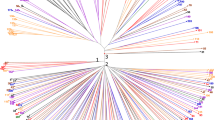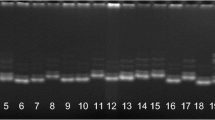Abstract
At present, testing for distinctness, uniformity and stability (DUS) of crop varieties relies on a set of morphological characters. These characters suffer fromthe limitations of number, interaction with the environment in which the variety grows and subjectivity in decision-making. The potential of DNA-based markers such as sequence tagged microsatellite site (STMS), for establishing DUS merits investigation. In the present study, a set of 55 mapped STMS markers, selected from 12 linkage groups of rice genome, was used to examine distinctness of 23 aromatic rice genotypes including the commercially important Basmati varieties. Forty-one of these markers (74.5%) showed polymorphism between the varieties. The number of alleles per locus ranged from 2–4 with an average of 2.3. The polymorphism information content (PIC) of the markers varied from 0.083 to 0.665 with an average of 0.338. All the varieties could be differentiated from each other at a low probability (0.07×10-13) of identical match by chance. The marker-based clustering of the varieties corresponded with the known phenotypic classification, thereby providing confidence in the distinctness established by the mapped STMS markers. The utility of these markers to study uniformity and stability was analysed using a commercially important crossbred Basmati rice variety Pusa Basmati 1(IET-10364) that contributes about 40–50% of Basmati rice export from India. Genotyping of twenty individual plants, grown from the nucleus, breeder, foundation, certified and farmer's saved seed samples using all the 55 markers revealed no variation among the plants. These observations suggested that the set of mapped markers employed in this study could be further used for establishing distinctness of aromatic rice varieties and for studying DUS of the important commercial variety Pusa Basmati 1.
Similar content being viewed by others
References
Ahuja, S.C., D.V.S. Pawar, U. Ahuja & K.R. Gupta, 1995. Basmati Rice-The scented Pearls, CCS Haryana Agricultural Univarsity, Hisar (India), pp. 63.
Bligh, H.F.J., N.W. Blackhall, K.J. Edwards & A.M. McClung, 1999. Using amplified fragment length polymorphisms and simple sequence length polymorphisms to identify cultivars of brown and white milled rice. Crop Sci 39: 1715–1721.
Bligh, H.F.J., 2000. Detection of adulteration of Basmati rice with non-premium long grain rice. Int J Food Sci Tech 35: 257–265.
Bredemeijer, G.M.M., R.J. Cook, M.W. Ganal, R. Peeters, P. Isaac, Y. Noordijk, S. Rendell, J. Jackson, M.S. Röder, K. Wendehake, M. Dijcks, M. Amelaine, V. Wickaert, L. Bertrand & B. Vosman, 2002. Construction and testing of microsatellite database containing more than 500 tomato varieties. Theor Appl Genet 105: 1019–1026.
Coburn, J.R., S.V. Temnykh, E.M. Paul & S.R. McCouch, 2002. Design and application of microsatellte marker panels for semiautomated genotyping of rice (Oryza sativa L.). Crop Sci 42: 2092–2099.
Cooke, R.J., 1995. Varietal identification of crop plants. In: J.H. Skerritt & R. Appels (Eds.), New Diagnostics in Crop Sciences, pp. 33–63. CAB Int., Wallingford.
Doyle, J.J. & J.L. Doyle, 1990. Isolation of plant DNA from fresh tissues. Focus 12: 13–14.
Glaszmann, J.C., 1987. Isozymes and classification of Asian rice varieties. Theor Appl Genet 74: 21–30.
Law, J.R., J.C. Reeves, J. Jackson, P. Donini, D. Matthews, J.S.C. Smith & R.J Cooke, 2001. Most similar variety comparisons-A grouping tool for use in distinctness, uniformity and stability (DUS) testing. ISHS Acta Hortic 546: 95–100.
McCouch, S.R., X.L. Chen, O. Panaud, S. Temnykh, Y. B. Xu, Y.G. Cho, N. Huang, T. Ishii & M. Blair, 1997. Microsatellite marker development, mapping and application in rice genetics and breeding. Plant Mol Biol 35: 89–99.
McCouch, S.R., L. Teytelman, Y. Xu, K.B. Lobos, K. Clare, M. Walton, B. Fu, R. Maghirang, Z. Li, Y. Xing, Q. Zhang, I. Kono, M. Yano, R. Fjellstrom, G. DeClerck, D. Schneider, S. Cartinhour, D. Ware & L. Stein, 2002. Development and mapping of 2240 new SSR markers for rice (Oryza sativa L). DNA Res 9: 199–207.
Nagaraju, J., M. Kathirvel, R.R. Kumar, E.A. Siddiq & S.E. Hasnain, 2002. Genetic analysis of traditional and evolved Basmati and non-Basmati rice variety by using fluorescence based ISSR-PCR and SSR markers. Proc Nat Acad Sci USA 99: 5836–5841.
Ni, J., Peter M. Colowit & David J. Mackill, 2002. Evaluation of genetic diversity in rice subspecies using microsatellite markers. Crop Sci 42: 601–607.
Olufowote, J.O., Y. Xu, X. Chen, W.D. Park, H.M. Beachell, R.H. Dilday, M. Goto & S.R. McCouch, 1997. Comparative evaluation of within cultivar variation of rice (Oryza sativa L.) using microsatellite and RFLP markers. Genome 40: 370–378.
Powell, W., M. Morgante, C. Andre, M. Hanafey, J. Vogel, S. Tingey & A. Rafalski, 1996. A comparison of RFLP, RAPD, AFLP and SSR markers for germplasm analysis. Mol Breed 2: 225–238.
Rohlf, F.J., 1998. NTSYS-pc. Numerical Taxonomy and Multivariate Analysis System, version 2.0, Exeter Software, Setauket, New York.
Riek, J. De, E. Calsyn, I. Everacrt, E. Van Bockstacle & M. De. Loose, 2001. AFLP based alternatives for assessment of Distinctness, Uniformity and Stability of sugar beet varieties. Theor Appl Genet 103: 1254–265.
Röder, M.S., K. Wendehake, V. Korzun, G.M.M. Bredemeijer, D. Laborie, L. Bertrand, P. Isaac, S. Rendell, J. Jackson, R.J. Cook, B. Vosman & M.W. Ganal, 2002. Construction and analysis of a microsatellite-based database of European wheat varieties. Theor Appl Genet 106: 67–73.
Santhy, V., T. Mohapatra, M. Dadlani, S.P. Sharma & R.P. Sharma, 2000. DNA markers for testing distinctness of rice (Oryza sativa L.). Plant Var Seeds 13: 141–148.
Singh, V.P., 2000. The Basmati rice of India. In: R.K. Singh, U.S. Singh & G.S. Khush (Eds.), Aromatic Rices, pp. 135–154. Oxford & IBH Publishing Co. Pvt Ltd., New Delhi.
Smith, J.S.C., E.C.L Chin, H. Shu, O.S. Smith, S.J. Wall, M.L. Senior, S.E. Michell, S. Kresovick & J. Ziegle, 1997. An evaluation of the utility of SSR loci as molecular markers in maize (Zea mays L.): Comparison with data from RFLPs and pedigrees. Theor Appl Genet 95: 163–173.
Temnykh, S., W.D. Park, N. Aires, S. Cartinhour, N. Hauch, L Lipovich, Y.G. Cho, T. Ishii & S.R. McCouch, 2000. Mapping and genome organization of microsetellite in rice (Oryza sativa L.). Theor Appl Genet 100: 697–712.
UPOV-BMT, 2002. BMT/36/10 Progress report of the 36th session of the technical committee, the technical working parties and working group on biochemical and molecular techniques and DNA-profiling in particular, Geneva.
Xiao, J., J. Li, L. Yuan, S.R. McCouch & S.D. Tankslay, 1996. Genetic diversity and its relationship to hybrid performance and heterosis in rice as revealed by PCR based markers. Theor Appl Genet 92: 637–643.
Yang, G.P., M.A.S. Maroof, C.G. Xu, Q. Zhang & R.M. Biyashev, 1994. Comparative analysis of microsatellite DNA polymorphism in land races and cultivars of rice. Mol Gen Genet 245: 187–194.
Author information
Authors and Affiliations
Corresponding author
Rights and permissions
About this article
Cite this article
Singh, R., Sharma, R., Singh, A. et al. Suitability of mapped sequence tagged microsatellite site markers for establishing distinctness, uniformity and stability in aromatic rice. Euphytica 135, 135–143 (2004). https://doi.org/10.1023/B:EUPH.0000014905.10397.08
Issue Date:
DOI: https://doi.org/10.1023/B:EUPH.0000014905.10397.08




